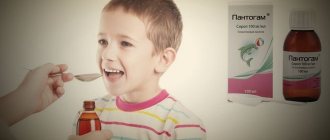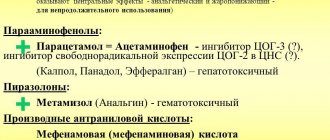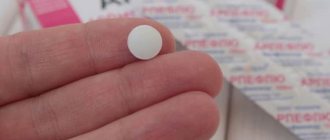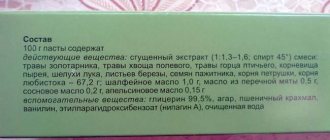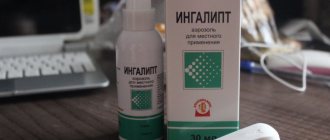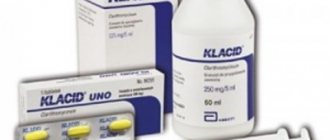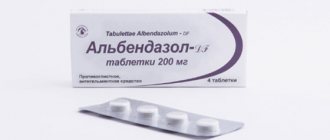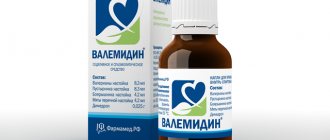Vegetative vascular dystonia, dysfunction of the autonomic system in adults, is treated by taking a wide range of drugs. Among them, a special place is occupied by nootropics, which help restore impaired cerebral circulation, and, therefore, get rid of panic attacks, groundless fears and other unpleasant symptoms of VSD.
Compound
INN (international nonproprietary name) is hopantenic acid.
Pantogam tablets
1 tablet contains 250 mg or 500 mg of hopantenic acid - the active substance.
Auxiliary ingredients according to the mass content of the active substance:
- 3.1 mg or 6.2 mg - calcium stearate;
- 0.8 mg or 1.6 mg - methylcellulose;
- 9.3 mg or 18.6 mg - talc;
- 46.8 mg / 93.6 mg - magnesium hydroxycarbonate.
Pantogam syrup
1 bottle contains 10 g/100 ml of hopantenic acid - the active substance.
Auxiliary ingredients:
- 15 g - sorbitol;
- 25.8 g - glycerol;
- 0.1 g - citric acid monohydrate;
- 0.05 g - aspartame;
- 0.1 g – sodium benzoate;
- 0.01 g — food flavoring “Cherry 667”;
- up to 100 ml - purified water.
Pharmacodynamics and pharmacokinetics
the neurotransmitter GABA in its structure . Directly affects the GABA (subtype B) receptor-channel complex. Shows anticonvulsant and nootropic activity, increases the brain's resistance to toxic effects and hypoxia. In neurons, it activates anabolic processes, reduces motor excitability, stimulates physical performance and mental activity of the body, combines moderate sedative effects with a mild stimulating effect.
In cases of chronic alcohol intoxication, as well as in cases of alcohol abstinence, it improves the metabolism of GABA. Shows the ability to inhibit acetylation reactions , which take part in the mechanism of inactivation of sulfonamides and procaine (Novocaine) , as a result of which their action is prolonged. Prevents the pathological increase in the bladder reflex and increased detrusor tone.
When taken orally hopantenic acid is quickly absorbed from the gastrointestinal tract, has the ability to pass through the blood-brain barrier , and creates the highest concentrations in the walls of the stomach, liver, skin and kidneys.
It cannot be metabolized and is excreted unchanged within 2 days. 28.5% of the drug is excreted in feces and 67.5% in urine.
Pharmacological group
Pantogam is one of the drugs belonging to the group of nootropics, which has a direct effect on the restoration of metabolic processes that continuously occur in brain tissue.
The composition of the drug is slightly similar to the composition of vitamins belonging to group B, therefore it performs the same functions. The basis of its effect on the human body is to increase the brain's resistance to periods of oxygen deficiency and the ability to eliminate toxins. This remedy has a pronounced sedative effect, it can increase mental abilities, relieve seizures and enhance the ability to remember.
In addition, the drug increases the ability to carry out various tasks, tones the muscular corset of the urinary system, helping with enuresis, and relieves intoxication of the body due to chronic alcohol consumption.
Indications for use Pantogam
Indications for the use of Pantogam tablets for adult patients and children starting from 3 years of age:
- cognitive impairment in neurotic disorders , as well as due to organic brain damage (including traumatic brain injury and the consequences of neuroinfections);
- extrapyramidal pathologies (hepatolenticular degeneration, parkinsonism, myoclonus epilepsy, Huntington's chorea, etc. ) ;
- cerebrovascular insufficiency , provoked by atherosclerotic abnormalities in the vascular structure of the brain ;
- prevention, as well as treatment of extrapyramidal syndrome (akinetic, hyperkinetic), due to taking antipsychotics;
- epilepsy occurring with inhibition of mental processes (prescribed in combination with anticonvulsant drugs);
- psycho-emotional excessive stress, decreased physical performance and mental activity, in order to improve memory and concentration;
- neurogenic changes in the process of urination (enuresis, frequent urination, urge incontinence, urgency);
- organic cerebral insufficiency in schizophrenia;
- Children over 3 years of age are prescribed Pantogam tablets for perinatal encephalopathy, mental retardation of varying severity, delayed motor, speech, mental development, or a combination thereof. Also for various forms of cerebral palsy, neurosis-like pathologies (tics, stuttering) , hyperkinetic manifestations (hyperactivity syndrome with observed attention deficit).
Indications for use of Pantogam for children from birth, in the form of syrup:
- perinatal encephalopathy (prescribed from birth);
- Cerebral palsy of varying severity;
- mental retardation of varying severity, including behavioral disorders;
- pathologies of psychological status (delayed mental or physical development, specific pathologies of motor functions, speech, as well as their combination);
- development of school skills in children (writing, reading, counting, etc.);
- senile dementia in its initial forms;
- hyperkinetic abnormalities, including attention deficit hyperactivity disorder;
- decreased mnestic-intellectual activity due to arteriosclerotic pathologies of cerebral vessels;
- trauma, toxic or neuroinfectious effects on the brain;
- neurosis-like conditions ( stuttering, inorganic encopresis , tics);
- cerebral organic pathology in schizophrenia (in combination with psychotropic drugs);
- extrapyramidal diseases ( Parkinson's disease , Huntington's syndrome , hepatolenticular degeneration, myoclonus epilepsy, etc.);
- therapy and prevention of extrapyramidal syndrome due to taking antipsychotics;
- decreased performance, both physical and mental, psycho-emotional overload, in order to improve memory and concentration;
- epilepsy with inhibition of mental processes and decreased cognitive productivity (in combination with anticonvulsants);
- urinary disorders of neurogenic etiology.
Properties of the drug
Pantogam has the following effect on the body:
- helps improve blood microcirculation;
- activates the work of mental activity and muscles;
- cleanses the body of alcohol toxins;
- relieves pain;
- increases performance;
- improves the medicinal effect of some analgesics and drugs from the sulfonamide group; accelerates the processes occurring in the brain responsible for speech.
Pantogam contains a substance that affects the cerebral vessels; it quickly passes from the stomach into the blood, after which it is concentrated in the organs of the excretory system, some of it remains in the skin cells and on the stomach walls.
Contraindications
The leaflet for the drug Pantogam indicates the following contraindications to its use.
For tablets:
- patient age under 3 years;
- breastfeeding period ;
- pregnancy period .
For the syrup:
- first trimester of pregnancy;
- phenylketonuria, due to the content of aspartame in the syrup.
Are common:
- hypersensitivity to hopantenic acid or other ingredients of the syrup or tablets;
- acute kidney pathologies in severe form.
Side effects
As a rule, therapy using Pantogam occurs without serious complications.
Sometimes side effects in the form of allergic reactions (rashes on the skin, conjunctivitis, rhinitis) . In this case, reduce the dose of Pantogam or cancel therapy with its use.
Also, noise in the head, sleep phase disturbances or daytime sleepiness were observed. These symptoms usually do not require discontinuation of treatment and are short-lived.
Overdose
This situation may arise if the dosage of the drug is accidentally or intentionally exceeded. An overdose manifests itself in increased adverse reactions from the body.
To get rid of negative symptoms, you should do a gastric lavage and drink activated charcoal, in a dosage according to the patient’s weight.
To prevent a situation where the safe dose of the drug is exceeded, you should not self-medicate and use Pantogam yourself. It is important to strictly follow the doctor’s recommendations and not exceed the dosage prescribed by him.
Instructions for use Pantogam (Method and dosage)
The medicine Pantogam in the form of syrup and tablets is prescribed orally after meals, after 15–30 minutes.
The preferred appointment time is before 16:00.
Pantogam tablets, instructions for use
The recommended single dose of Pantogam in the form of tablets for adult patients is 250 mg - 1000 mg, the daily dosage is 1500 mg - 3000 mg.
Children from 3 years of age are prescribed tablets in a single dose ranging from 250 mg to 500 mg, the daily dosage is 750 mg - 3000 mg.
The course of therapy usually takes from 30 to 120 days, in some cases up to six months. After a 3 or 6 month break, you can repeat the course of treatment.
For combination therapy of epilepsy , Pantogam is prescribed in a daily dose of 750 mg - 1000 mg, for a year or more.
In the combined treatment of extrapyramidal neuroleptic syndrome , up to 3 g of the drug is taken over several months.
When conducting combination therapy of extrapyramidal hyperkinesis in patients with hereditary pathological conditions of the nervous system , a daily dose of 500 mg to 3000 mg is recommended for up to 4 months or even more.
To neutralize the consequences of head injury and neuroinfections - 0.25 g (250 mg) of Pantogam, taken 3 - 4 times a day.
To restore performance in conditions of asthenia and excessive stress - 3 times a day, 250 mg.
For the treatment of extrapyramidal syndrome , due to the use of antipsychotics , it is recommended for adult patients 500 mg - 1000 mg, three times a day; for children, the recommended dosage is from 250 mg to 500 mg in 3-4 doses. Treatment lasts from 1 to 3 months.
Children with tics are prescribed 3-6 doses per day at a dose of 250 mg to 500 mg, for 1 to 4 months.
For problems with urination, adult patients take Pantogam tablets 2-3 times a day, 500 mg - 1000 mg; pediatric patients: 250 mg - 500 mg (the recommended daily dose varies from 25 mg to 50 mg per kilogram of weight). The course of therapy is carried out over 1 to 3 months.
Depending on age, children with various diseases of the nervous system are prescribed from 1 to 3 g of Pantogam.
The dosage regimen most often boils down to increasing the dose over 7–12 days, followed by taking the maximum dose of Pantogam for 15–40 days, with a slow decrease in the maximum dose (7–8 days) until the drug is completely discontinued.
If a repeated course of therapy is necessary, the break should be from 1 to 3 months.
Pantogam syrup, instructions for use
Adult patients are prescribed a single dose of 2.5 ml - 10 ml, the daily dosage is 15 ml - 30 ml.
For children from 0 months, a single dose of 2.5 ml - 5 ml is recommended, the daily dosage is 7.5 ml - 30 ml.
Therapy is carried out for 1 to 4 months, less often up to 6 months. Re-prescribing Pantogam is possible after a break of 3-6 months.
The recommended range of daily doses for children, depending on pathology and age, is:
- from 0 to 12 months – 5 ml – 10 ml;
- up to 3 years – 5 ml – 12.5 ml;
- from 3 to 7 years – 7.5 ml – 15 ml;
- over 7 years old – 10 ml – 20 ml.
Treatment tactics recommend increasing the daily dose over 7–12 days, followed by taking the maximum dose for 15–40 or more days with a gradual dose reduction (7–8 days) until the drug is discontinued . The course of therapy ranges from 30 to 90 days (for the treatment of some diseases up to 6 months or even more).
For combination therapy of epilepsy with parallel administration of anticonvulsants , 7.5 ml - 10 ml per day is prescribed. Treatment lasts for 12 months or more.
For the combined treatment of schizophrenia with the joint use of psychotropic drugs, 5 ml - 30 ml per day is recommended, with a course of treatment from 30 days to 3 months.
When treating neuroleptic syndrome , with concomitant extrapyramidal disorders, take a daily dose of the drug of up to 30 ml of syrup. Therapy is carried out over several months.
When treating the consequences of head injury and neuroinfections, a daily dosage of 5 ml to 30 ml is prescribed.
For extrapyramidal hyperkinesis , for the treatment of patients with organic pathologies of the nervous system , a daily dose of syrup from 5 ml to 30 ml is recommended. The course of therapy is up to 4 months or more.
The syrup is taken in order to restore performance during asthenia and excessive stress three times a day in a dose of 2.5 ml - 5 ml.
Children with urinary disorders are prescribed 2.5 ml - 5 ml, with a daily dose equal to 0.25 ml - 0.5 ml per kilogram of weight. The course of therapy lasts from 30 days to 3 months; for adults, it is recommended to take syrup 2-3 times a day, 5 ml - 10 ml.
When carrying out long-term therapy, parallel administration of drugs with identical effects is not recommended.
Features of use for VSD
People who experience unpleasant symptoms of VSD are advised to use antidepressants, nootropics, vasodilators, beta-blockers and other medications. Some people benefit from decoctions of medicinal herbs, while others benefit from homeopathy. There is no universal prescription for treatment, because dystonia differs in its manifestations, and its therapy is aimed, first of all, at eliminating them.
As for Pantogam, its use as a nootropic is justified for vegetative-vascular dystonia.
After 2-3 weeks of treatment, patients notice the following changes in their condition:
- strengthening the blood vessels of the brain, due to which dizziness and flickering of spots before the eyes disappear;
- normalization of the nervous system, which makes a person calmer;
- increased activity;
- increased performance;
- elimination of toxins from the body, due to which the metabolic process in the body begins to go faster;
- strengthening the heart muscle, so heart disease appears somewhat less frequently.
Pantogam eliminates groundless anxiety and suspiciousness, improves mood, enhances the effect of neuroleptics, which relieve headaches.
You should not hope to get rid of VSD by using Pantogam or other groups of medications. In order for unpleasant symptoms to occur less and less frequently, you should change your lifestyle:
- practice meditation;
- have a good rest;
- spend more time in the fresh air;
- exercise;
- Healthy food;
- take massage courses regularly.
Interaction
Pantogam, when taken in combination with barbiturates , prolongs their action.
When used together with anticonvulsants, it enhances their effectiveness.
Prevents the side effects of Carbamazepine, Phenobarbital, and neuroleptics.
Potentiates the effects of drugs for local anesthesia (Procaine).
The effect of Pantogam is enhanced by complex treatment with etidronic acid and Glycine.
special instructions
With long-term use of Pantogam, it is not recommended to simultaneously prescribe other nootropic drugs and drugs that stimulate the central nervous system.
The break between courses of therapy with Pantogam, like any other nootropic drug, should be 1-3 months.
Impact on the ability to drive vehicles and complex mechanisms
Due to the likelihood of drowsiness in the first days of therapy, caution should be exercised when driving a car and performing potentially hazardous types of work.
Pantogam's analogs
Level 4 ATX code matches:
Bravinton
Acefen
Carnicetine
Pyracesin
Nooclerin
Semax
Piracetam
Olatropil
Fezam
Vinpocetine
Cerebrocurin
Cavinton Forte
Calcium Hopanthenate
Glutamic acid
Cephabol
Olanzapine
Cerebrolysate
Pramistar
Sidnocarb
Vinpotropil
When looking for alternative medicines, you may be offered the following Pantogam analogues:
- Vinpocetine;
- Ginkgo biloba;
- Glycine;
- Cavinton;
- Lutsetam;
- Cortexin;
- Nootropil;
- Piracetam;
- Cerebrolysin;
- Thiocetam;
- Encephabol and many others.
For children
Pantogam for children in the form of tablets is used only upon reaching the age of 3; starting from birth, you can take the drug for children in the form of syrup.
Reviews from doctors about Pantogam tablets, in the treatment of many neurological diseases in children starting from 3 years of age, are positive in 99 cases out of 100. The therapy is highly effective with minimal side effects. It is worth noting that the effect of the drug does not occur immediately, but most often, 1-1.5 months after the first dose.
Side effects of Pantogam in children are rare and most often consist of drowsiness or sleep disturbance. It is possible that these manifestations depend on the time of taking the drug, which is not recommended to be taken after 4 o’clock in the afternoon.
On user forums dedicated to drugs for the treatment of various childhood neurological pathologies, a large place is discussed about the drug Pantogam for children. Feedback from forum visitors regarding hyperactivity, stuttering , mental and physical impairments, tics , lack of attention, problems with urination, etc. mostly positive.
Let us recall that Pantogam in tablet form does not have a sufficient clinical research base, and is also physically inconvenient for infants to take, which is why Pantogam tablets are not prescribed to children under 3 years of age.
When is Pantogam prescribed?
There are clear indications for the use of the drug. We list those indicated in the instructions:
- Perinatal encephalopathy - with this diagnosis, syrup is started to be given to newborns.
- In various variants of cerebral palsy, newborns are also given to drink.
- Mental retardation due to behavioral abnormalities.
- Psychological pathologies, these include various developmental delays - mental, physical, deviations of motor and speech functions (DSR).
- Hyperactivity and other hyperkinetic disorders.
- Mental deviations due to neurotic disorders associated with cognitive (cognitive) processes. Sometimes such disorders are caused by brain injuries or occur during the recovery period after neuroinfections.
- Tic, stuttering, inorganic neopresis and other neurotic conditions.
- Schizophrenia and related cerebral organic disorders. In these cases, the medicine is used in combination with psychotropic drugs.
- Huntington's syndrome, Parkinson's disease and similar diseases.
- Epileptic seizures, which may result in deterioration of mental perception, as well as inhibition of cognitive processes. In such situations, Pantogam is prescribed together with other medications that have an anticonvulsant effect.
- Deviations in the functioning of the genitourinary system of a neurogenic nature. These include enuresis, frequent urination, and other imperative-type disorders.
- To support psycho-emotional balance during stressful situations, as well as to improve physical condition, increase performance, and enhance mental activity.
- As an “assistant” in the development of reading, writing, counting and logical thinking skills that school-age children need.
Newborns
The drug Pantogam for newborns can only be prescribed by an experienced pediatrician, since it is very difficult to independently notice deficiencies in the development of a child at this age.
Speaking about the effectiveness and advisability of prescribing Pantogam for newborns, reviews from parents are quite contradictory. Some are grateful to the doctors for the timely detection of a problem in the development of their own child and note its further full development, others ignored the advice of the pediatrician and also did not feel any pathological changes.
In any case, even when prescribed for no reason, the drug Pantogam syrup has practically no side effects, and in case of real problems, it will certainly help solve them. After all, often the price of taking a medicine on time can be negligible compared to the possible negative consequences of inaction.
Reviews about Pantogam
Pantogam tablets, for the treatment of various neurological disorders indicated in the instructions for use, receive positive reviews from doctors who use them in their practice. When taken by adults, reviews of Pantogam indicate excellent results of the therapy. 98% of patients are absolutely satisfied with the outcome of the treatment and are ready to trust this drug in the future.
When taken by children, reviews of Pantogam are no less positive, including reviews of tablets when taken by children from 3 years of age, as well as reviews of Pantogam syrup for children starting from 0 months.
For infants, reviews of Pantogam are more varied and do not come to a clear opinion. The thing is that many parents do not trust their pediatricians and often do not follow their recommendations, preferring self-medication and the “natural” development of the child. It is worth noting that often they are really right and the normal development of the baby takes place without any medications.
Only an experienced and respectable pediatrician can give infants the correct diagnosis and provide adequate treatment. One way or another, you make the decision to conduct any treatment for your child, so approach this with all responsibility, taking into account the opinions of several doctors and your own intuition.
Which is better: Pantogam or Pantocalcin?
In fact, Pantogam and Pantocalcin are synonyms, that is, their active ingredient is the same substance. Judging by the reviews of experts, the effectiveness and cost of these drugs are almost identical. In this regard, the interchangeability of these drugs is possible.
Complex of opinions
According to doctors, Pantogam is effective in treating children under 10 years of age. This is too weak a remedy for adults.
In children, improvement occurs within a week. The effect of the drug is mild, it does not overstimulate the child. It is distinguished by a convenient release form, safety, and affordable price. The downside is the possibility of an allergic reaction and skin rashes.
There are many reviews online from parents of children who were treated with this drug. Many mothers did not understand the reasons for prescribing this medicine and did not undergo treatment.
Some note that after the start of therapy, disturbances occurred in the gastrointestinal tract, and increased excitability was observed in the child. But there are still many more positive reviews about Pantogam; the drug helped cure stuttering, the consequences of a head injury, the condition of newborns significantly improved, and other positive results were noted.
Adult patients report significant improvements in chronic fatigue, insomnia and stress.
Based on the advice of patients, the drug should not be used for preventive purposes; therapy should be prescribed by a doctor according to indications. This is due to the possible manifestation of allergic symptoms, which can harm the patient’s health.
Pantogam price, where to buy
The cost of the drug Pantogam depends on its pharmacological form (tablets for adults and children over 3 years of age or syrup for children), as well as on the region and pharmacy chain.
On average, you can buy Pantogam in Russian pharmacies:
- price of Pantogam tablets 500 mg No. 50 – 550 rubles;
- price of Pantogam for children from 3 years old in tablets 250 mg No. 50 – 350 rubles;
- price of Pantogam syrup for children from 0 months 10% 100 ml No. 1 – 350 rubles.
- Online pharmacies in RussiaRussia
- Online pharmacies in KazakhstanKazakhstan
ZdravCity
- Pantogam tablets 500 mg 50 pcs. PIK-PHARMA PRO LLC/PIK-PHARMA LEK LLC
611 rub. order - Pantogam active capsules 300 mg 60 pcs. PIK-PHARMA PRO LLC/PIK-PHARMA LEK LLC
RUR 466 order
- Pantogam syrup 10% 100mlVips-Med/Pik-Pharma
RUB 404 order
- Pantogam tablets 250 mg 50 pcs. PIK-PHARMA PRO LLC/PIK-PHARMA LEK LLC
405 rub. order
Pharmacy Dialogue
- Pantogam tablets 250 mg No. 50Pik-Pharma Pro
428 RUR order
- Pantogam tablets 500 mg No. 50Pik-Pharma Lek
RUR 658 order
- Pantogam syrup 10% 100mlVIPS-Med
RUB 396 order
- Pantogam Active capsules 300 mg No. 60Pik-Pharma Lek
502 rub. order
- Pantogam syrup 10% 100mlPik-Pharma Pro
RUR 442 order
show more
